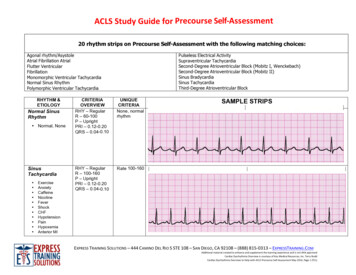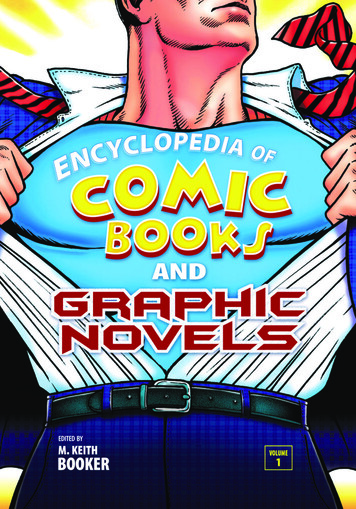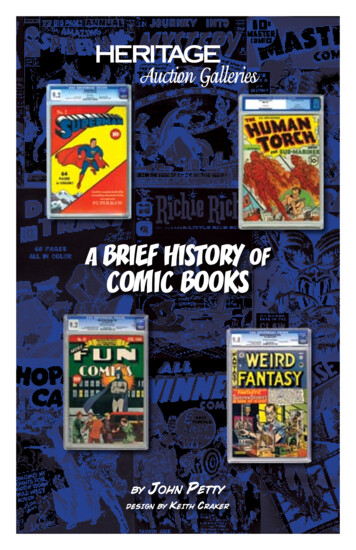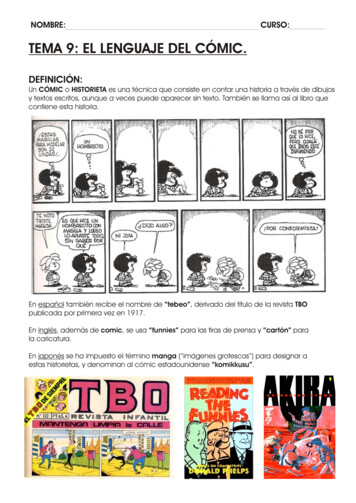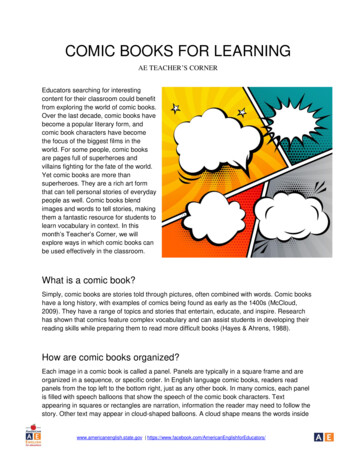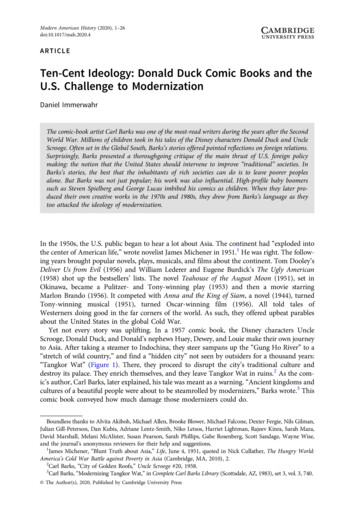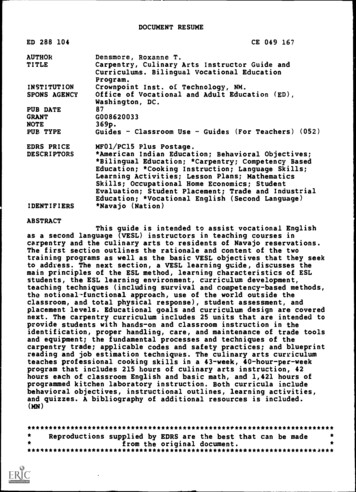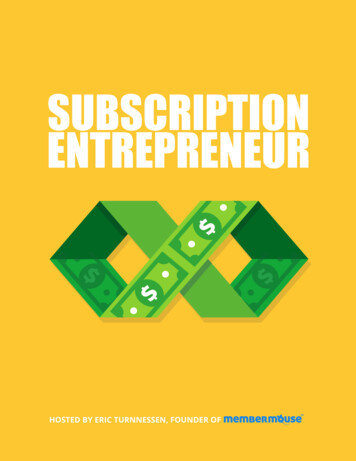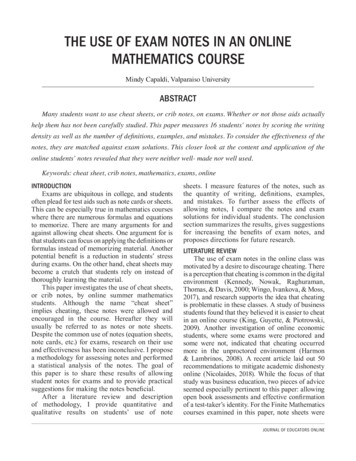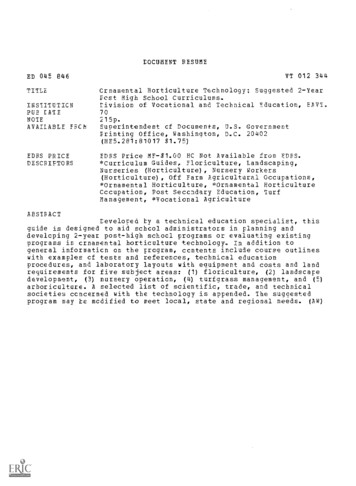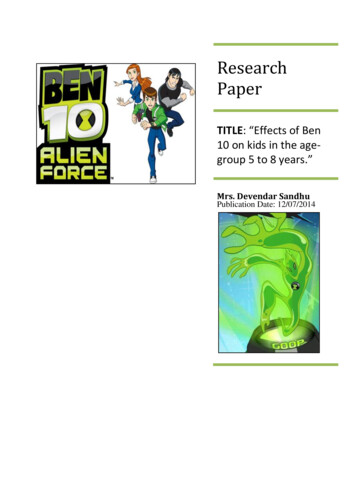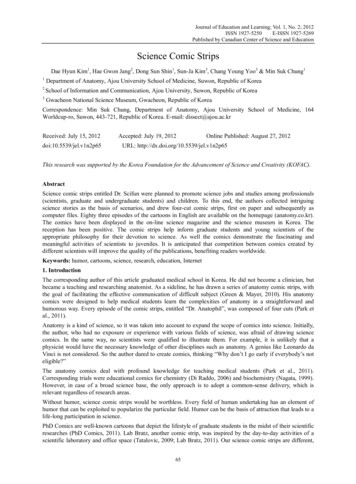
Transcription
Journal of Education and Learning; Vol. 1, No. 2; 2012E-ISSN 1927-5269ISSN 1927-5250Published by Canadian Center of Science and EducationScience Comic StripsDae Hyun Kim1, Hae Gwon Jang2, Dong Sun Shin1, Sun-Ja Kim3, Chang Young Yoo3 & Min Suk Chung11Department of Anatomy, Ajou University School of Medicine, Suwon, Republic of Korea2School of Information and Communication, Ajou University, Suwon, Republic of Korea3Gwacheon National Science Museum, Gwacheon, Republic of KoreaCorrespondence: Min Suk Chung, Department of Anatomy, Ajou University School of Medicine, 164Worldcup-ro, Suwon, 443-721, Republic of Korea. E-mail: dissect@ajou.ac.krReceived: July 15, 2012doi:10.5539/jel.v1n2p65Accepted: July 19, 2012Online Published: August 27, 2012URL: http://dx.doi.org/10.5539/jel.v1n2p65This research was supported by the Korea Foundation for the Advancement of Science and Creativity (KOFAC).AbstractScience comic strips entitled Dr. Scifun were planned to promote science jobs and studies among professionals(scientists, graduate and undergraduate students) and children. To this end, the authors collected intriguingscience stories as the basis of scenarios, and drew four-cut comic strips, first on paper and subsequently ascomputer files. Eighty three episodes of the cartoons in English are available on the homepage (anatomy.co.kr).The comics have been displayed in the on-line science magazine and the science museum in Korea. Thereception has been positive. The comic strips help inform graduate students and young scientists of theappropriate philosophy for their devotion to science. As well the comics demonstrate the fascinating andmeaningful activities of scientists to juveniles. It is anticipated that competition between comics created bydifferent scientists will improve the quality of the publications, benefiting readers worldwide.Keywords: humor, cartoons, science, research, education, Internet1. IntroductionThe corresponding author of this article graduated medical school in Korea. He did not become a clinician, butbecame a teaching and researching anatomist. As a sideline, he has drawn a series of anatomy comic strips, withthe goal of facilitating the effective communication of difficult subject (Green & Mayer, 2010). His anatomycomics were designed to help medical students learn the complexities of anatomy in a straightforward andhumorous way. Every episode of the comic strips, entitled “Dr. Anatophil”, was composed of four cuts (Park etal., 2011).Anatomy is a kind of science, so it was taken into account to expand the scope of comics into science. Initially,the author, who had no exposure or experience with various fields of science, was afraid of drawing sciencecomics. In the same way, no scientists were qualified to illustrate them. For example, it is unlikely that aphysicist would have the necessary knowledge of other disciplines such as anatomy. A genius like Leonardo daVinci is not considered. So the author dared to create comics, thinking “Why don’t I go early if everybody’s noteligible?”The anatomy comics deal with profound knowledge for teaching medical students (Park et al., 2011).Corresponding trials were educational comics for chemistry (Di Raddo, 2006) and biochemistry (Nagata, 1999).However, in case of a broad science base, the only approach is to adopt a common-sense delivery, which isrelevant regardless of research areas.Without humor, science comic strips would be worthless. Every field of human undertaking has an element ofhumor that can be exploited to popularize the particular field. Humor can be the basis of attraction that leads to alife-long participation in science.PhD Comics are well-known cartoons that depict the lifestyle of graduate students in the midst of their scientificresearches (PhD Comics, 2011). Lab Bratz, another comic strip, was inspired by the day-to-day activities of ascientific laboratory and office space (Tatalovic, 2009; Lab Bratz, 2011). Our science comic strips are different,65
www.ccsenet.org/jelJournal of Education and LearningVol. 1, No. 2; 2012in that the strips are from the viewpoint of a professor. The varying sorts of science comics, equipped with theirown philosophies, would widen choices of readers, so that the author didn’t hesitate to generate the cartoons.Purpose of the science comic strips in this trial is to encourage other scientists, graduate and undergraduatestudents, even children performing their scientific activities and learning. For fulfilling the aim, it has been triedto collect the interesting science stories and to draw comics delivering the funny tales efficiently.2. MethodsDr. Scifun was made almost identically to preceding anatomy comic strips (Park et al., 2011). The science comicstrips also featured the corresponding author with the indistinguishable character. However, his nickname waschanged from Dr. Anatophil to Dr. Scifun (Figure 1). Scifun, a compound word encompassing science and fun,was the homonym of siphon, a scientific term. Like the siphon draws and conveys water, Dr. Scifun wasexpected to draw and convey scientific humor and message. The procedures to create science comics were asfollows.Figure 1. Feature of one episode of the science comic stripsTitle “Dr. Scifun” is followed by subtitle, four frames of cartoons, and the author’s remark66
www.ccsenet.org/jelJournal of Education and LearningVol. 1, No. 2; 20122.1 Acquisition of StoriesInitially, funny stories associated with science were gathered by reading books, conversations with others,watching the television, or searching the Internet. Recording the idea was essential.2.2 Writing of ScenariosStories were put down as they happened to Dr. Scifun, who was a funny scientist and professor. The supportingcharacters were Dr. Scifun’s unnamed graduate students, acquainted researchers, friends, and family members.The scenarios required dramatic composition such as logic, expectation followed by satisfaction, and pleasantreversal.The narrative text of each comic strip was written in four paragraphs, matching the final frame count. One moreparagraph was the author’s compensatory comment introducing background of the episode (Figure 1).2.3 Drawing of Comics on PaperThe text of each scenario was illustrated with pencil and paper. The stationery was chosen so that the scenariocould be simply altered during illustration. In other words, the writing and sketching were a fluid process thatinfluenced each other.2.4 Drawing of Comics on ComputerThe paper version of each comic strip was digitized using graphic software. Among the several accessiblesoftware packages available for this purpose, Adobe Illustrator CS5 (Adobe Systems, San Jose, CA, USA) wasselected because vector lines could be easily modified using anchor points; the lines were conveniently filledwith colors. It was possible that the lines were duplicated in other cuts for reducing repetitive work. Furthermore,texts from the scenario in a word processor format could be copied onto the Adobe Illustrator (Hwang et al.,2005). The computer drawing was performed by part-time workers. Even with a changing staff, it was possibleto maintain consistency of pictures (Figure 2-4).Figure 2. Comic strips dealing with scientific humor67
www.ccsenet.org/jelJournal of Education and LearningFigure 3. Comic strips showing the interesting lives of scientistsFigure 4. Comic strips encouraging graduate students and junior scientists68Vol. 1, No. 2; 2012
www.ccsenet.org/jelJournal of Education and LearningVol. 1, No. 2; 20122.5 Distribution of ComicsEach episode was converted into a BMP (bitmap) file with high resolution (300 dpi) (Figs. 2-4). The BMP filesand the supplementary text files of author’s comments were uploaded on the homepage (anatomy.co.kr) (Figure1).Prior to production of an English version of the comics, a Korean version was introduced in the on-line popularscience magazine (Science On, 2012). Since February, 2010, the comic strips have been uploaded serially everyweek (Figure 5).Figure 5. Comic strips uploaded in the Korean science magazine (left) and those on displayin the science museum (right)The comic strips were exhibited in the Gwacheon National Science Museum, the largest Korean one close to thecapital city, Seoul. The Korean and English versions were used for domestic and foreign visitors, respectively(Figure 5).3. ResultsScience comics demand a novel idea and time for development and execution. In our experience, after hatching astory for one episode, the actual manufacture of the strip spent 9 hours: 3 hours for writing, 3 hours for sketchingon paper, and another 3 hours for the computer drawing. In fact, decades of episodes were simultaneouslyprocessed as a mass production. Eighty-three episodes can now be viewed at the website. No payment orregistration is required.In the on-line science magazine, the comic strips have been the most popular corner. Korean readers’ replies onthe bulletin board of homepage have generally been favorable (Science On, 2012). The visitors to the sciencemuseum did not miss the exhibition of comic strips. Most of them laughed irrespective of ages, which seemed apositive response (Figure 5).4. DiscussionScience and comics share similarities - both require an idea that is unique and creative. Of course, other fieldssuch as the literature and painting also necessitate uniqueness and creativity. But, just science and comics can beobjectively evaluated by the public. Science and comics in the same nature constitute a harmonious combination.Comics have an enormous capacity to relate science stories and convey scientists’ message to the audience(McCloud, 1993). This was exemplified in the study to build a science curriculum that incorporated comic stripsand provided students with opportunities to read, discuss, and respond to the contents of these comics. Thecomic strips stimulated students’ interest in science issues and promoted science literacy (Olson, 2008). Inanother study, children exposed to science comics were able to give scientific explanations for the comics basedon their own experiences (Weitkamp & Burnet, 2007). Spurred by curiosity from science comics in yet anotherstudy, children were motivated to look for more information in magazines, newspapers, the Internet, and othersources (Rota & Izquierdo, 2003). Posters that involve science-themed comics enhanced the public’sunderstanding of science across multiple generations (Naylor & Keogh, 1999).While the above is encouraging, we have noted a deficit of current science comics: most cartoonists who writeand sketch the comics do not have formal science training or actual experience as scientists. Veteran scientistsare likely to describe scientific jokes and scientists’ lives more specifically and persuasively. The scientists’69
www.ccsenet.org/jelJournal of Education and LearningVol. 1, No. 2; 2012writing may be translated to images by professional cartoonists. But, the process of translating scripts is alsocrucial, as artists can distort writers’ visions (Tatalovic, 2009). It is, therefore, desirable that a scientistsimultaneously note and illustrate the comics.The available commercial comics are usually aimed at children’s curiosity. Dissimilarly, the author has wanted tomainly satisfy grownup readers rather than juveniles. Cultivated adults prefer logical jokes based on thescientific contents. For example, the jokes in the comics could pleasantly explain how science is related to dailylife (Figure 2).High schools students can be reluctant to specialize in science because of the preconception that living as ascientist is boring and exhausting. Science comic strips could be a novel tool to demonstrate the intriguing andworthwhile activities of scientists. For example, the authors often dwell on negative traits of Dr. Scifun, such asvulgarity, which could be a human touch of a scientist (Figure 3).We intended the comic to encourage young researchers like graduate students, whose enthusiasm and dedicationto their science craft can wane. In this light, the comic strips comprising lessons of the experienced person couldbe a source of renewal and re-devotion. Furthermore, the comic could influence their creativity by providingperspectives from other fields in science as well as empathic, observational, and communication skills ofscientists (Figure 4) (Green & Myers, 2010).The job of writing and drawing a comic is more understandable by comparison with production of a theatricalmovie. Acquisition and composition of stories to create a scenario are almost the same for both a comic and amovie. The comic is then drawn on paper, which is similar to continuity work with still scenes for film. In otherwords, preliminary jobs prior to comic drawing on computer are not so different from those before filming. Thefinal job, computer illustrating of comic, does not require a significant effort, in contrast to the major process ofshooting with actors and actresses, followed by editing.We hope that other scientists will draw comics and distribute them freely through the Internet as we do. Thecompetition between science comics including PhD Comics (PhD Comics, 2011) would improve their ownlevels, which will benefit all readers. Even scientists without drawing talent are capable of cartoon productionthrough help from computer graphic software. That is why we have detailed our illustration methods in thispublication. Referring to the author’s technique, others can develop their own unique methods.The creation and educational use of comic strips are ongoing to account for the science and scientist’s life withrelated humor. Another 80 episodes in English will be presented around the close of 2012. The authors willimprove the comic medium in the science museum to enhance the scientific interest of the visitors. There is thepossibility that science comic strips are converted either into versions for different equipments (e.g., smartphone)or into a variety of animations (e.g., flash animation).There seems to be numerous persons who read the Dr. Scifun in the homepage and the science museum. Theon-line and off-line readers’ opinions will be surveyed in a subsequent investigation. An objective assessment ofhow the science comics are perceived by reading public and to what degree they aid diverse students and otherscientists is planned. Evaluative narrative comments from viewers in different countries would also beworthwhile.ReferencesComics. (2011). Piled higher & deeper life (or the lack thereof) in academia. Chico: Piled Higher and DeeperPublishing.Di Raddo, P. (2006). Teaching chemistry lab safety through comics. Journal of Chemical Education, 83, 571-573.http://dx.doi.org/10.1021/ed083p571Green, M. J., & Myers, K. R. (2010). Graphic medicine: Use of comics in medical education and patient care.British Medical Journal, 340, 863. http://dx.doi.org/10.1136/bmj.c863Hwang, S. B., Chung, M. S., & Park, J. S. (2005). Anatomy cartoon for common people. Korean Journal ofAnatomy, 38, 433-441.Lab Bratz (2011). Lab Bratz by Ed Dunphy & Helber Soares. Miami, FL: Jimbo Inc.McCloud, S. (1994). Understanding comics: The invisible art. New York, NY: William Morrow Paperbacks.Nagata, R. (1999). Learning biochemistry through manga: Helping students learn and remember, 0052-770
www.ccsenet.org/jelJournal of Education and LearningVol. 1, No. 2; 2012Naylor, S., & Keogh, B. (1999). Science on the underground: An initial evaluation. Public Understanding ofScience, 8, 105-122. http://dx.doi.org/10.1088/0963-6625/8/2/303Olson, J. C. (2008). The Comic strip as a medium for promoting science literacy. California State University,Northridge.Park, J. S., Kim, D. H., & Chung, M. S. (2011). Anatomy comic strips. Anatomical Sciences Education, 4,275-279. http://dx.doi.org/10.1002/ase.224Rota, G., & Izquierdo, J. (2003). “Comics’’ as a tool for teaching biotechnology in primary schools. ElectronicJournal of Biotechnology, 6, 85-89.Science On. (2012). Dr. Scifun. Retrieved from http://scienceon.hani.co.kr/?mid media&category 221Tatalovic, M. (2009). Science comics as tools for science education and communication: A brief, exploratorystudy. Journal of Science Communication, 8, 1-17.Weitkamp, E., & Burnet, F. (2007). The Chemedian brings laughter to the chemistry classroom. InternationalJournal of Science Education, 29, 1911-1929. http://dx.doi.org/10.1080/0950069070122279071
Comics have an enormous capacity to relate science stories and convey scientists’ message to the audience (McCloud, 1993). This was exemplified in the study to build a science curriculum that incorporated comic strips and provided students with opportunities to read, discuss, and resp
